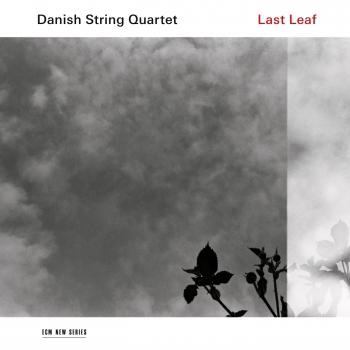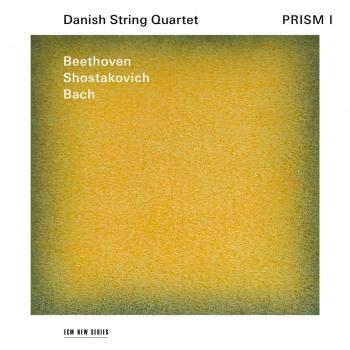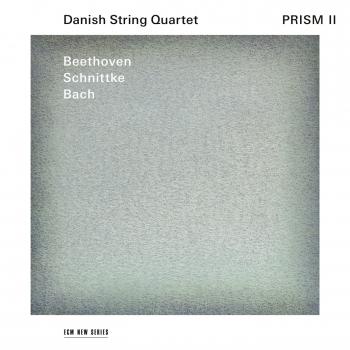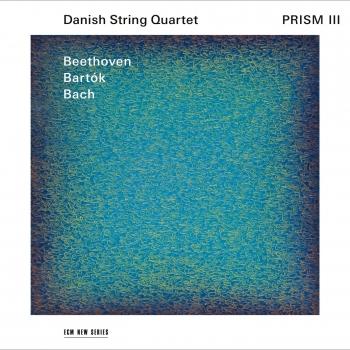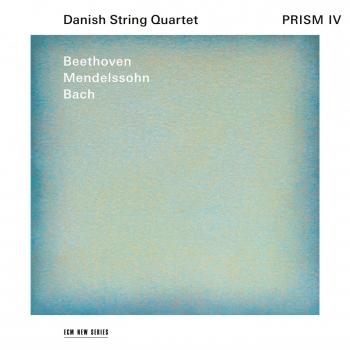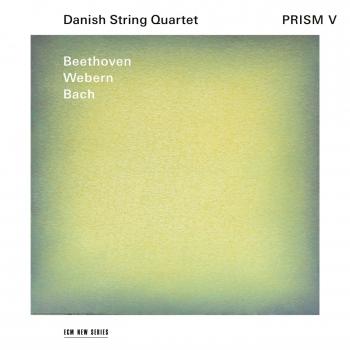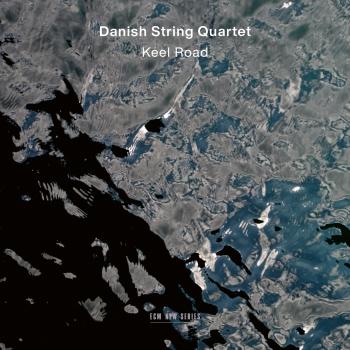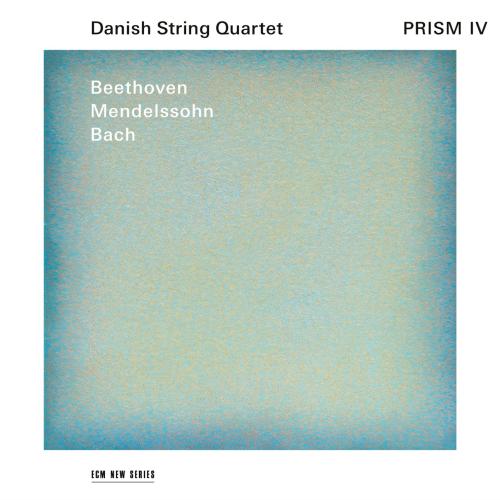
Prism IV Danish String Quartet
Album info
Album-Release:
2022
HRA-Release:
03.06.2022
Label: ECM New Series
Genre: Classical
Subgenre: Chamber Music
Artist: Danish String Quartet
Composer: Johann Sebastian Bach (1685-1750), Ludwig van Beethoven (1770-1827), Felix Mendelssohn Bartholdy (1809-1847)
Album including Album cover Booklet (PDF)
I`m sorry!
Dear HIGHRESAUDIO Visitor,
due to territorial constraints and also different releases dates in each country you currently can`t purchase this album. We are updating our release dates twice a week. So, please feel free to check from time-to-time, if the album is available for your country.
We suggest, that you bookmark the album and use our Short List function.
Thank you for your understanding and patience.
Yours sincerely, HIGHRESAUDIO
- Johann Sebastian Bach (1685 - 1750): The Well-Tempered Clavier / Book 1, BWV 846-869:
- 1 J.S. Bach: The Well-Tempered Clavier / Book 1, BWV 846-869: Fugue in G Minor, BWV 861 (Arr. Förster for Strings) 01:47
- Ludwig van Beethoven (1770 - 1827): String Quartet No. 15 in A Minor, Op. 132:
- 2 Beethoven: String Quartet No. 15 in A Minor, Op. 132: I. Assai sostenuto - Allegro 09:46
- 3 Beethoven: String Quartet No. 15 in A Minor, Op. 132: II. Allegro ma non tanto 09:10
- 4 Beethoven: String Quartet No. 15 in A Minor, Op. 132: III. Molto adagio - Andante 18:15
- 5 Beethoven: String Quartet No. 15 in A Minor, Op. 132: IV. Alla marcia, assai vivace - Più allegro 02:08
- 6 Beethoven: String Quartet No. 15 in A Minor, Op. 132: V. Allegro appassionato - Presto 06:59
- Felix Mendelssohn (1809 - 1847): String Quartet No. 2 in A Minor, Op. 13:
- 7 Mendelssohn: String Quartet No. 2 in A Minor, Op. 13: I. Adagio - Allegro vivace 07:50
- 8 Mendelssohn: String Quartet No. 2 in A Minor, Op. 13: II. Adagio non lento 08:46
- 9 Mendelssohn: String Quartet No. 2 in A Minor, Op. 13: III. Intermezzo. Allegretto con moto - Allegro di molto 05:16
- 10 Mendelssohn: String Quartet No. 2 in A Minor, Op. 13: IV. Presto - Adagio non lento 09:51
Info for Prism IV
The Danish String Quartet's Grammy-nominated Prism project, linking Bach fugues, Beethoven quartets and works by later masters, receives its fourth installment. The penultimate volume of the series combines Bach's Fugue in G minor from the Well-Tempered Clavier (in the arrangement by Viennese composer Emanuel Aloys Frster) with Beethoven's String Quartet Op. 132 and Felix Mendelssohn's String Quartet No.2 (composed in 1827). As Paul Griffiths observes in the liner notes, these pieces "sound all the more remarkable for the exquisite brilliance and precision of the Danish players".
Recorded in the historic Reitstadel Neumarkt, the album is issued as the Danish String Quartet is in the midst of an extensive tour across the United States and Europe.
This is the Danish String Quartet’s fourth instalment in the Prism series, the group’s ongoing project that will ultimately hold five volumes of recordings linking Bach fugues with Beethoven quartets and quartets by alternating later composers. While the preceding volumes presented quartets by masters who lived to experience the 20th century – these being, in order of their appearance in the series: Dmitri Shostakovich, Alfred Schnittke and Béla Bartók – Prism IV finds the Danish musicians interpreting Felix Mendelssohn’s (1809-1847) String Quartet No.2. As Paul Griffiths remarks in the liner notes, the quartet’s interpretation of Mendelssohn is empowered by Beethoven’s model in terms of “vivid gesture, contrapuntal energy, harmonic boldness and formal innovation”. The piece is paired with Beethoven’s String Quartet No. 15 and Bach’s Fugue in G minor in the arrangement of the Austrian educator and composer Emanuel Aloys Förster.
Praised by The New York Times for “playing of unusual, and unusually effective, liberty” and a tone that “throbs with joy”, The Danish String quartet have built a reputation for their unique interpretations of both traditional and contemporary repertory, often opposing contrasting material and idioms within a programme. The group’s violist Asbjørn Nørgaard has explained that in the past, the quartet members had become “slightly bored with much of the classical music programming. Too much randomness, too little connection.” As they attended a back-to-back performance of Wagner’s Prelude to Lohengrin and Ligeti’s Atmosphères, interpreted by the Berlin Philharmonic under Simon Rattle, they came to a collective realization that ultimately gave birth to the idea for the Prism concept: “connecting masterworks” and “creating a completely new framing but with elegance and respect”, as Nørgaard puts it.
In his liner essay, Paul Griffiths traces different connections between these pieces and their composers – motif-based between Bach and Beethoven, and broader, yet also more immediate ties connecting the latter’s composition to Mendelssohn, who created his Quartet only months after Beethoven’s passing in 1826. “Mendelssohn at this point probably knew all five of Beethoven’s late quartets and certainly was aware of the last, still unpublished when, in July 1827, he began the response that was to occupy his next three months. It was in the finale of Beethoven’s op. 135 […] that he found his starting point, similarly a question. Keeping the rhythm and contour of Beethoven’s ‘Muss es sein?’, he narrowed its intervals in his own ‘Ist es wahr?’, which he drew from a love song he had jotted down the month before.” Elsewhere in his piece, however, Mendelssohn closely follows the model of Beethoven’s op. 132, down to elegant imitations of its most central themes.
Mendelssohn’s quartet abounds in references, alluding to, at times even imitating Beethoven’s tonal organization and use of contrast, though each nod to Beethoven also reveals a step towards a different direction, as Mendelssohn’s string quartet offers alternative answers to old questions. In the same vein, Beethoven’s motif development in the first movement of his String Quartet in A minor proves deeply informed by Bach’s Well-Tempered Clavier, though it is not the head motif of the Fugue in G minor, but that of the C-sharp minor Fugue, to which the American musicologist Lewis Lockwood has drawn parallels. The Danish String Quartet’s interpretation of the G minor Fugue – one of Bach’s best known fugues and occasionally referred to as the “Little Fugue” – leads gracefully into Beethoven’s string quartet, confirming the quartet’s claim that “Beethoven is not a disconnected island in music; it is a continuation from Bach and the old masters”. Mendelssohn continues the lineage.
Danish String Quartet
Danish String Quartet
As a string quartet, we find ourselves at the core of the classical music world. On a daily basis we delve deeply into works by great masters such as Beethoven and Mozart, but we also play the occasional folk gig. Over the years we have been fortunate to study in many different places in masterclasses with renowned teachers and have had opportunities to perform in major concert halls across the world. Sometimes a friendly reviewer has written nice things about us too. We have participated in competitions and made some recordings as well. If you want to know more about all this stuff, check out the ‘press‘ page on our site, where you can download a PDF with all the text you could hope for.
Here’s a simpler story of the quartet: We are three Danes and one Norwegian cellist, making this a truly Scandinavian endeavor. We are often joking about ourselves being modern Vikings – perhaps a touch more harmless than our ancestors – we are not pillaging cities or razing the English coastline! We are simply your friendly neighborhood string quartet with above average amounts of beard.The three of us met very early in our lives in the Danish countryside at an amazing summer camp for enthusiastic amateur musicians. Not yet teenagers, we were the youngest players, so we hung out all the time playing football and chamber music together. During the regular school year we would get together often to play music and just have fun. We became best friends. In 2001, professor Tim Frederiksen of The Royal Academy of Music in Copenhagen got in touch with us and started coaching us on a regular basis. All of the sudden, at the ages of 15 and 16, we were a serious string quartet. It all happened so fast that none of us seemed to notice the transition.
Time passed and we grew up. We were enrolled at The Royal Academy of Music and our life as music students had begun. Funnily enough, none of us have any memory of our lives without the string quartet. In 2008 Norwegian cellist Fredrik joined in, generously adding to the amount of beard and general Vikingness of the group. We found him hidden away in a castle outside Stockholm. During his free time, Fredrik can be found fixing or sailing his sailboat somewhere in Scandinavia.The rest of us spend time with different hobbies – old cars, cooking, gaming, reading, playing, talking, and drinking. Yes, playing string quartets is our job, and yes it is hard work, but we mostly do it for pleasure, like we always did.There is so much amazing music to delve into, and our hope is to continue our travels through life and music together as a quartet. We want to be able to share our music with as many people as possible. And of course, the ultimate goal is to beat Valentin Berlinsky’s (Borodin String quartet) world record of “most years in the same chamber music group”. We will reach that goal around 2060 and on that day we will host a giant feast – you shall all be invited!
Booklet for Prism IV










